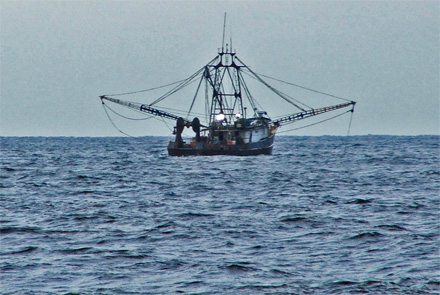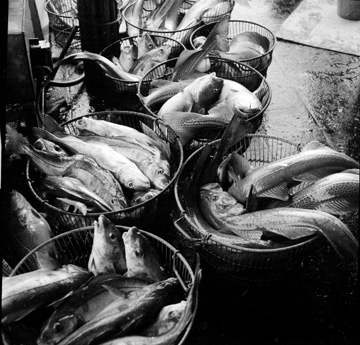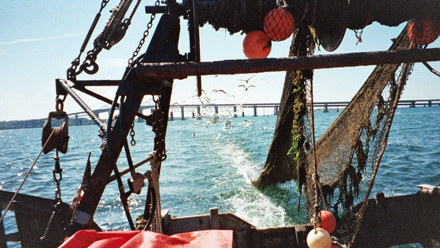Navigation
National Oceanic and Atmospheric Administration (NOAA) Announces Interim Rules to Reduce Overfishing and Rebuild Northeast Groundfish Stocks
NOAA on April 6, 2009 announced interim fishing measures that protect the Northeast groundfish stocks most in trouble, while still allowing the fishing industry to target some healthy stocks as the fishery rebuilds.
 |
| Groundfish boat. .Photo: NOAA |
NOAA on April 6, 2009 announced interim fishing measures that protect the Northeast groundfish stocks most in trouble, while still allowing the fishing industry to target some healthy stocks as the fishery rebuilds. The new rules, which take effect May 1, balance economic and conservation concerns, and are an important step toward ending overfishing by 2010 as required by the Magnuson-Stevens Act.
“This decision balances healthy fishing communities and sustainable fisheries,” Under Secretary of Commerce for Oceans and Atmosphere and NOAA Administrator Jane Lubchenco said. “It builds a solid bridge to a larger, long-term solution for managing the fishery through catch shares, which will help restore the ecosystem and the economic health of the fishing communities. The system will give fishermen more of a stake in how the fishery is managed.”
The new measures will:
- Continue to allow commercial fishermen to target healthy stocks such as haddock on Georges Bank and in the Gulf of Maine. The healthy state of the haddock fishery shows that stocks respond when appropriate management action is taken to reduce catches, if needed.
- For hook gear fishermen, expand the size of the area where they have special access to haddock and lengthen the fishing period in it from three months (October to December) to nine months (May to January).
- Decrease minimum legal size for haddock by one inch, allowing more fish caught to be landed.
- Give businesses more flexibility by allowing roll-over of unused bycatch allocations during the first three quarters of the fishing year, and freer transfer of groundfish permits and leasing of days-at-sea.
- Enlarge the fishing area in southern New England waters where each fishing day-at-sea is counted as two days against an individual vessel's total days-at-sea allotment to give greater protection to winter flounder, the stock most in need of protection.
- Prohibit vessels from keeping southern New England winter flounder, northern windowpane flounder, and ocean pout.
- Limit witch flounder landings to 1,000 pounds per day-at-sea, or up to 5,000 pounds per trip.
“While the new interim rule is a critical step to restoring depleted fish stocks and ensuring a profitable fishing industry for future generations, I understand it is a difficult one for many fishermen and their families,” said Lubchenco. “That’s why I have directed my staff to conduct a review of NOAA’s budget to see how we can mitigate costs to the industry during this transition.”
According to Patricia Kurkul, northeast regional administrator for NOAA’s Fisheries Service, NOAA took public comments into consideration in formulating the new rules, as well as assurances from the New England Fishery Management Council that it will fully address conservation objectives.
“Based on the public input and further economic analyses, the final interim measures better balance economic and conservation concerns than NOAA’s January proposal,” Kurkul said. “Today’s final rule starts with the council’s proposal for an interim action and adds important conservation protections for stocks of particular concern.”
NOAA’s January proposal would have resulted in a 20 percent reduction in total fishing revenues. The final interim rule will result in a 9 percent reduction, nearly matching the New England Fishery Management Council’s original 8 percent proposal.
 |
| Basket of haddock. .Photo: NOAA |
Also, new recreational fishing measures will help protect cod and southern New England winter flounder. These include limiting anglers on charter/party boats to 10 Georges Bank cod per angler per day, extending by two weeks the current prohibition on keeping Gulf of Maine cod, and prohibition on keeping southern New England winter flounder.
The council and NOAA are working together to develop new groundfish management measures which will include an expanded number of fishing sectors — a group of vessel permit holders who voluntarily agree to fishing restrictions and procedures in exchange for a share of the total catch allocated to the industry. This system based on catch shares will replace the current method of limiting fishing through days at sea for those vessels that join a sector.
 |
| Small northeast groundfish trawler. Photo: NOAA |
There are already two groundfish sectors operating in New England and 17 more proposed that could encompass the majority of groundfish boats in the Northeast.
NOAA’s long-term goals for the fishery include establishing fishing capacity at a level consistent with both conservation objectives and a profitable industry. These goals also entail the expansion of cooperative research so the best possible science is used in regulating the fishery, and the improvement of gear technology so fishermen can continue to target healthy stocks.
Rebuilding groundfish stocks and putting in place robust, well-monitored and effective sectors is a top priority for NOAA, and it prompted Lubchenco to hold a series of meetings to listen to the concerns of the region. NOAA’s Fisheries Service also did careful analyses of the likely economic and biological effects of today’s interim measures.
“Each and every day, fishermen and women bring healthy seafood to our tables and provide for their families,” Lubchenco said. “We cannot, and will not, allow this proud and vital industry to disappear. We will be a good partner with fishing communities, keeping the lines of communication open, listening to their concerns and needs.”
The interim measures are in addition to the 18 percent reduction in days-at-sea already slated to go into effect May 1, and retention of the existing area in the Gulf of Maine where every day fished is counted as two days.
The news in this article was provided by NOAA.
Search
Latest articles
Agriculture
- World Water Week: Healthy ecosystems essential to human health: from coronavirus to malnutrition Online session Wednesday 24 August 17:00-18:20
- World Water Week: Healthy ecosystems essential to human health: from coronavirus to malnutrition Online session Wednesday 24 August 17:00-18:20
Air Pollution
- "Water and Sanitation-Related Diseases and the Changing Environment: Challenges, Interventions, and Preventive Measures" Volume 2 Is Now Available
- Global Innovation Exchange Co-Created by Horizon International, USAID, Bill and Melinda Gates Foundation and Others
Biodiversity
- It is time for international mobilization against climate change
- World Water Week: Healthy ecosystems essential to human health: from coronavirus to malnutrition Online session Wednesday 24 August 17:00-18:20
Desertification
- World Water Week: Healthy ecosystems essential to human health: from coronavirus to malnutrition Online session Wednesday 24 August 17:00-18:20
- UN Food Systems Summit Receives Over 1,200 Ideas to Help Meet Sustainable Development Goals
Endangered Species
- Mangrove Action Project Collaborates to Restore and Preserve Mangrove Ecosystems
- Coral Research in Palau offers a “Glimmer of Hope”
Energy
- Global Innovation Exchange Co-Created by Horizon International, USAID, Bill and Melinda Gates Foundation and Others
- Wildlife Preservation in Southeast Nova Scotia
Exhibits
- Global Innovation Exchange Co-Created by Horizon International, USAID, Bill and Melinda Gates Foundation and Others
- Coral Reefs
Forests
- NASA Satellites Reveal Major Shifts in Global Freshwater Updated June 2020
- Global Innovation Exchange Co-Created by Horizon International, USAID, Bill and Melinda Gates Foundation and Others
Global Climate Change
- It is time for international mobilization against climate change
- It is time for international mobilization against climate change
Global Health
- World Water Week: Healthy ecosystems essential to human health: from coronavirus to malnutrition Online session Wednesday 24 August 17:00-18:20
- More than 400 schoolgirls, family and teachers rescued from Afghanistan by small coalition
Industry
- "Water and Sanitation-Related Diseases and the Changing Environment: Challenges, Interventions, and Preventive Measures" Volume 2 Is Now Available
- Global Innovation Exchange Co-Created by Horizon International, USAID, Bill and Melinda Gates Foundation and Others
Natural Disaster Relief
- STOP ATTACKS ON HEALTH CARE IN UKRAINE
- Global Innovation Exchange Co-Created by Horizon International, USAID, Bill and Melinda Gates Foundation and Others
News and Special Reports
- World Water Week: Healthy ecosystems essential to human health: from coronavirus to malnutrition Online session Wednesday 24 August 17:00-18:20
- STOP ATTACKS ON HEALTH CARE IN UKRAINE
Oceans, Coral Reefs
- World Water Week: Healthy ecosystems essential to human health: from coronavirus to malnutrition Online session Wednesday 24 August 17:00-18:20
- Mangrove Action Project Collaborates to Restore and Preserve Mangrove Ecosystems
Pollution
- Zakaria Ouedraogo of Burkina Faso Produces Film “Nzoue Fiyen: Water Not Drinkable”
- "Water and Sanitation-Related Diseases and the Changing Environment: Challenges, Interventions, and Preventive Measures" Volume 2 Is Now Available
Population
- "Water and Sanitation-Related Diseases and the Changing Environment: Challenges, Interventions, and Preventive Measures" Volume 2 Is Now Available
- "Water and Sanitation-Related Diseases and the Changing Environment: Challenges, Interventions, and Preventive Measures" Volume 2 Is Now Available
Public Health
- Honouring the visionary behind India’s sanitation revolution
- Honouring the visionary behind India’s sanitation revolution
Rivers
- World Water Week: Healthy ecosystems essential to human health: from coronavirus to malnutrition Online session Wednesday 24 August 17:00-18:20
- Mangrove Action Project Collaborates to Restore and Preserve Mangrove Ecosystems
Sanitation
- Honouring the visionary behind India’s sanitation revolution
- Honouring the visionary behind India’s sanitation revolution
Toxic Chemicals
- "Water and Sanitation-Related Diseases and the Changing Environment: Challenges, Interventions, and Preventive Measures" Volume 2 Is Now Available
- Actions to Prevent Polluted Drinking Water in the United States
Transportation
- "Water and Sanitation-Related Diseases and the Changing Environment: Challenges, Interventions, and Preventive Measures" Volume 2 Is Now Available
- Urbanization Provides Opportunities for Transition to a Green Economy, Says New Report
Waste Management
- Honouring the visionary behind India’s sanitation revolution
- Honouring the visionary behind India’s sanitation revolution
Water
- Honouring the visionary behind India’s sanitation revolution
- Honouring the visionary behind India’s sanitation revolution
Water and Sanitation
- Honouring the visionary behind India’s sanitation revolution
- Honouring the visionary behind India’s sanitation revolution

